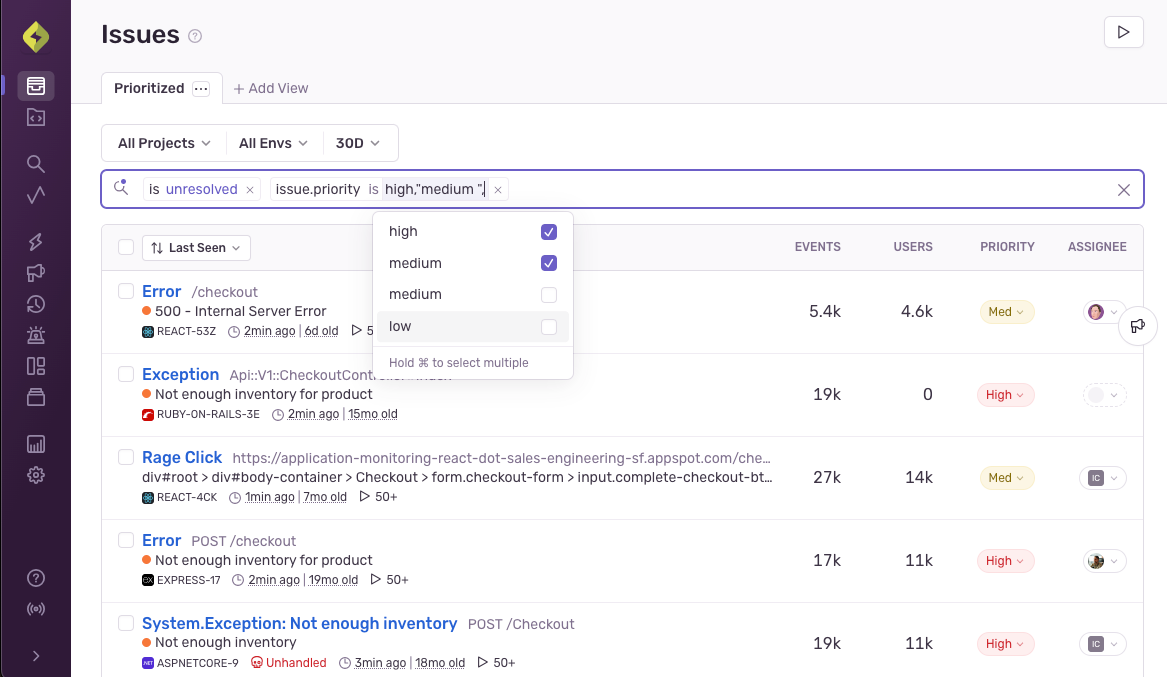AI-Powered Updates–Issue Grouping, Autofix, Anomaly Detection, and more
AI-Powered Updates–Issue Grouping, Autofix, Anomaly Detection, and more
What if you could not only find software issues you care about but also have the fix ready? We just introduced several updates that intelligently group new issues, reducing noise by about 40% and automatically suggesting fixes to annoying bugs you shouldn’t have to think about.
Reduce noise with AI grouping and priority alerts
Error noise has long been the nemesis of efficient debugging. You’re in the middle of tracking down a tricky bug, and suddenly, another alert, then another, until your feed’s a cluttered mess—like that drawer full of tangled cables and old batteries.
Our new AI grouping feature tackles this by swapping traditional rule-based fingerprints for “semantic” fingerprints. Built by a model that understands the context and meaning behind errors, these semantic fingerprints create a detailed representation of each issue, enabling intelligent grouping of new errors that stem from the same underlying problem. Importantly, this representation can easily be compared across issues, allowing us to compute the difference between errors as they come in efficiently. This approach is more reliable in handling the nuances of code refactors, version updates, and function recursion—places where static heuristics fall short.
Beta users have already seen a 40% reduction in issue volume across JavaScript, Ruby, and Python SDKs—meaning less noise, more signal, and actual progress.
Complementing AI grouping, enhanced issue priority further reduces noise by:
Filtering out low-priority issues that don’t significantly impact your application
Escalating alerts for sudden error spikes with smart algorithms
Enhanced issue priority combines AI grouping’s semantic understanding of issues with a classification model to identify non-actionable or low-priority errors. The updated default alert rule with priority-based conditions proactively filters out low-priority issues from triggering alerts by classifying issues into different priority levels. For added protection, the Escalating Issues detection feature triggers alerts when significant spikes in issue volume are detected, ensuring minor issues don’t become major problems.
AI Grouping is available to all organizations, while Priority Alerts is exclusive to Business and Enterprise plans. Both features currently support JavaScript, Ruby, and Python projects, with more language support coming soon. No setup is required; if you use one of the supported SDKs, you will see reduced noise in your issue feed today.
Beta users have already seen a 40% reduction in issue volume…
Debug without getting derailed
While everyone lives for the thrill of a cryptic error that hijacks the next two days of progress on that feature your CEO customers won’t stop asking about, fixing issues shouldn’t always mean getting derailed. With Issue Summary and Autofix, we’re giving you instant context on issues and automating the fix so that you can spend less time lost in the weeds and more time shipping.
Issue Summary steps in as your personal bug interpreter, instantly translating complex error data into clear, actionable summaries. It highlights key details like where the error is happening, what’s causing it, and the impact on users, so you’re not left deciphering code hieroglyphs.
Instead of seeing “Null pointer in module XYZ,” you’d get a clear rundown: “Null pointer in user data fetch, causing login to fail.” Now, you know exactly where to start without wasting time sifting through ambiguous traces.
But even when you pinpoint what happened, implementing a fix isn’t always straightforward. Tracking down the root cause, finding the best fix, and pushing it live all requires time that you’d rather spend on, well, pretty much anything else.
Autofix (now in beta)
Performs comprehensive root cause analysis to pinpoint precisely where and why the issue occurred, saving time spent scrolling through call stacks and function chains.
Explains its thought process along the way by surfacing insights as it searches for the root cause and solution to your issue.
Creates pull requests with proposed solutions so you don’t have to start from scratch.
Generates unit tests that validate you’ve fixed the problem - we know what the problem was, so we can automatically generate a unit test reproducing it.
Think of it as your debugging sidekick—getting you 90% of the way there so you can focus on fine-tuning. Instead of a vague “error in function,” Autofix digs deeper, showing you “Null reference in line 57 caused by missing user ID validation. Let’s add a validation step before processing the login.” It drafts a pull request with the needed validation logic and even suggests a unit test to catch the error in future builds.
Autofix might sound too good to be true—root cause analysis, suggested fixes, pull requests, and even unit tests created all in a few clicks? However, since launching internally, Autofix has found the correct root cause 94.5% of the time—and fixed the issue with its suggested code changes 53.6% of the time. Sure, it’s a small sample size, and we’re not saying it’s magic, but as we roll out Autofix in beta, it’s already showing it can tackle all the debugging work you’d rather not have to do.
To get started, opt into Sentry AI. You can find it in the Solutions Hub on the issue details page—just click into any error from the Issues page.
Autofix has found the correct root cause 94.5% of the time—and actually fixed the issue with its suggested code changes 53.6% of the time.
Experience fewer false alarms with anomaly detection
Setting manual metric alert thresholds is a game of guessing—and re-guessing. Too sensitive, and your feed’s a mess of false alarms; not sensitive enough, and you risk missing critical issues when they actually happen.
With Sentry’s anomaly detection, you get smarter, adaptive monitoring that flags only true problems, cutting down on noise and guesswork. Powered by Matrix Profiles, anomaly detection learns your system’s unique behavior patterns over time, spotting genuinely unusual activity without constant tuning. It also adapts to shifting baselines, so you’re not pinged for every minor fluctuation.
For example, if your system sees a gradual uptick in response times, anomaly detection recognizes this as part of the “new normal” and holds off on alerting. But if that spike suddenly goes beyond what’s typical, you’ll get a focused alert, pinpointing what actually needs your attention.
Want to try it out? Anomaly detection is available for early adopters. To create a new alert, head to the alerts tab within the left nav bar and click 'Create Alert'.
Share your feedback with Sentry
These new features are our biggest step yet in making issue management a little less painful, and we’d love your feedback. Head over to your Sentry account to try them out, join the conversation on Discord—and help shape where these features go next.
Don’t have a Sentry account yet? No problem—you can try it for free or request a demo to get started.






